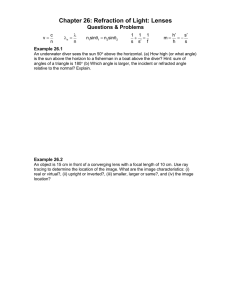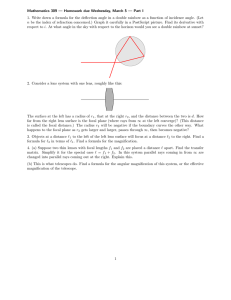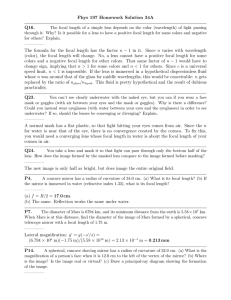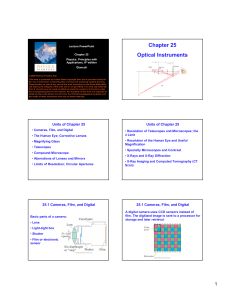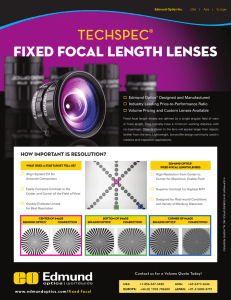1 f
advertisement
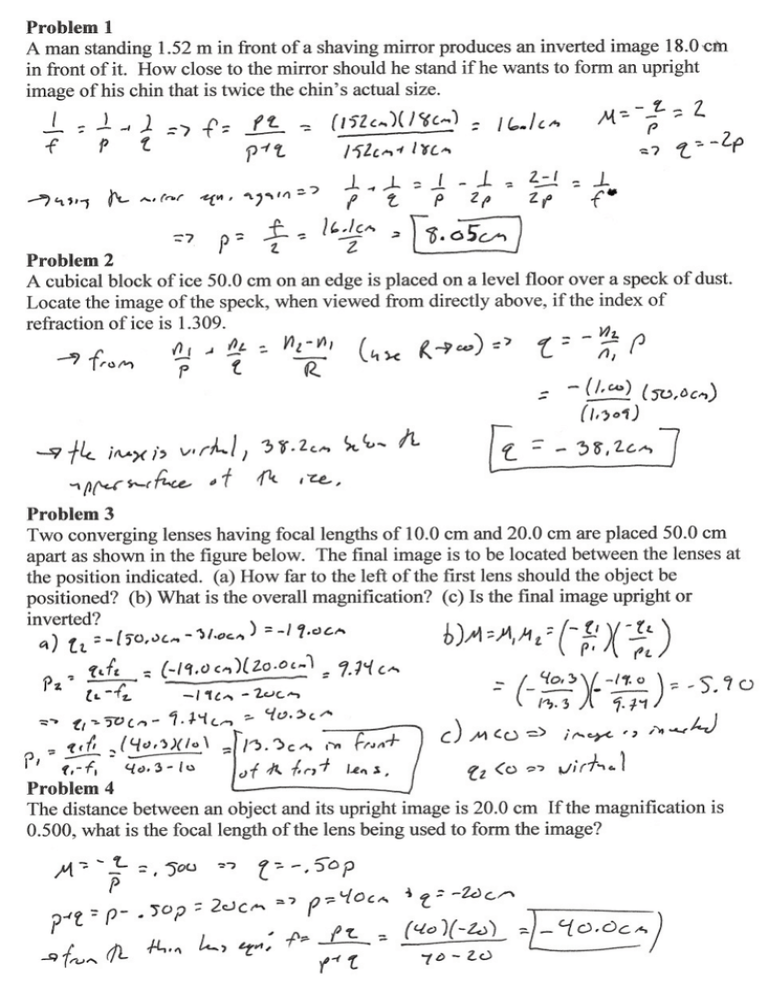
Problem 1
A man standing 1.52 m in tTontof a shaving mirror produces an inverted image 18.0'Ctn
in front of it. How close to the mirror should he stand if he wants to form an upright
image of his chin that is twice the chin's actual size.
.l. -: 1
f
p
..,
)
t
f
::...,
f f.. -:: ( 15Z,,.)(1~c.:::)
::: Ir
==
p-ft
Vil,,.,-t 1,,(.,.,
I ".,...
I -- -, .,..L
-?
-"J~ ""1 i'c- A,(n.r ~.., -I.,,",'"-
f
t
p
f{ ':.- J:.
('
" '"
~7
~
2.
t. -=-If
1 -- l-I
-- -- J-J
zf' 1.f
f-
=7
~ r~. O)~ - )
P : j:2. ~ }'-.:l.f"
Z
Problem 2
A cubical block of ice 50.0 cm on an edge is placed on a level floor over a speck of dust.
Locate the image of the speck, when viewed tTomdirectly above, if the index of
retTactionof ice is 1.309.
4'
'tf1:(J
1I~cc:»::>
{I, ~ ~ :. YlrV1, (
L = - 11,
r
t
If
t,)<"
:: - (I,r-) (~,()c",,)
(/,')01 )
~
f'-<. jfV.X
j, rtl/,
3 r. 2,... ~~... IL
..,{If'<-'~(
~
fit
\.11
tJ
i
[f.
,-ce..,
;::
- ~~. 2".., 1
Problem 3
Two converging lenses having focal lengths of 10.0 cm and 20.0 cm are placed 50.0 cm
apart as shown in the figure below. The final image is to be located between the lenses at
the position indicated. (a) How far to the left of the first lens should the object be
positioned? (b) What is the overall magnification? (c) Is the final image upright or
inverted?
- a ' c. - ')/.(;),...) = -I ,.dG'"
'" ) !l ~- I , ...
b)A =)4,)1 t ~ p~' )( -~:
-,
"
.. f..ft
.,,~ lL-it.
-
)
- "q
=
( I~.~ x 1-;.., ) ~J . to
(-
:; (-I 'Ie) ''''' )[Zo." ,...1 :: 1.1'1 ,...
--- J, - -11- 0
'10,
-1'1,... - '2.c.Jc...,
-'"'
-:::...!t"';VCf't-
"1.J."(<
::- 'I.t.J.,>,,,.-.
--
c) ft\ CQ -=-) "f'.~"
i'r'-J..J
- "r it ( C;tJ,'))( /0' -- I"').') c ,-.,. to ,,+
'1",
-- 3- lu cJf Jt.. /.r,-f ,~" ~,
f,-f, - 'ld.
Problem 4
The distance between an object and its upright image is 20.0 cm If the magnification is
0.500, what is the focal length of the lens being used to form the image?
"~
)tt
~
~..!-
p
=, joCJ ~., l ';. -, 5"D P
-2
?.Jt ':' p- .. !O
~
..t
/h
'(f1.J
II C-
P
-
1.1
I
""""'1 ~)
, 0-;:.'10'... ~ t
c:.Jc~
~""
r
' -fp.
f t..
f..(
1.:
-
~
:: -2<) c.,"'"
("0 )(-tc))
(,,-loCo)
;:.1.:-'tC),c)c_~/
Problem 5
A parallel beam of light enters a glass hemisphere perpendicular to the flat face as shown
below. The radius is R = 6.0 em, and the index ofrefTaction is n = 1.56. Determine the
point at which the beam is focused. (Assume paraxial rays; that is, all rays are located
close to the principal axis).
Pc.-k-~~1~', (t,,")
-
... c"7~
4't-
"
rr..Jtc.I:7
~
IL".,,~
k~
...
IL,
~)
r= (,U
Problem 6
You are told that a particular converging lens has focal length of 25 em, and that it
produces a virtual image which is 0.5 m away from the lens. What is the magnification?
1 -I 1
p
=-
-
j
')
f -
'l
tt.<00;:,') vr
r1
1
1",,",)oC-
Problem 7
Light fToman object passes through two lenses placed on the x-axis. A diverging lens
with focal length 1 m is located at x=-.5 m, and a converging lens with focal length .75 m
is located at x=.5 m. If the resultant real image is located at x=2 m, at what position on
the x-axis is the original object located?
'lz. ~Zf\ll
t
I
:=1
-.! =.J
f If,
oJ.J.::
t1
-L = j
-I ~
~
)
.1-
-.
5"
:') () -:: I
, I
\ ('1(-:.-1.)"")

